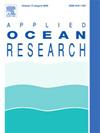Faster than real-time, phase-resolving, data-driven model of wave propagation and wave–structure interaction
IF 4.4
2区 工程技术
Q1 ENGINEERING, OCEAN
引用次数: 0
Abstract
A machine learning time-series prediction approach is proposed for wave propagation and wave load prediction. Under unidirectional wave conditions and variable bathymetry, given a wave gauge upstream, a model is shown to reproduce wave elevation or wave forces downstream under irregular steep and either non-breaking or breaking conditions. Attempts to perform the opposite calculation, predicting upstream conditions from downstream measurements, results in higher error, likely due to information loss under breaking conditions. For choice of machine learning approach, comparisons show that the Time-series Dense Encoder (TiDE) approach results in a good balance between model complexity, stability, computational time, and error. Over a flat bottom, time-series of wave elevation can be predicted up to 10 wavelengths away, though with a degraded accuracy compared to shorter distances. Similar results are shown for time-series of forces on a vertical cylinder, showing better results than a simple Morison approach, as used in engineering tools such as OpenFAST, but with a similarly fast computational time. Generalizations show that training on irregular wave data permit extrapolations to periodic wave cases. Finally, the same method also is also demonstrated at field-scale, comparing results between two offshore buoys.
比实时更快、相位解析、数据驱动的波传播和波与结构相互作用模型
针对波浪传播和波浪载荷预测提出了一种机器学习时间序列预测方法。在单向波浪条件和多变水深条件下,给定上游波浪测量值后,模型可再现下游不规则陡坡、非断裂或断裂条件下的波高或波浪力。如果尝试进行相反的计算,即根据下游测量结果预测上游情况,则误差会更大,这可能是由于破浪条件下的信息丢失造成的。对于机器学习方法的选择,比较结果表明,时间序列密集编码器(TiDE)方法在模型复杂性、稳定性、计算时间和误差之间取得了良好的平衡。在平坦的海底,波高的时间序列可以预测到 10 个波长的距离,但与较短的距离相比,精度有所下降。垂直圆柱体受力的时间序列也显示了类似的结果,与简单的莫里森方法(如 OpenFAST 等工程工具中使用的方法)相比,结果更好,但计算时间同样较短。归纳结果表明,对不规则波浪数据的训练可以推断出周期性波浪的情况。最后,同样的方法还在现场规模上进行了演示,比较了两个海上浮标的结果。
本文章由计算机程序翻译,如有差异,请以英文原文为准。
求助全文
约1分钟内获得全文
求助全文
来源期刊

Applied Ocean Research
地学-工程:大洋
CiteScore
8.70
自引率
7.00%
发文量
316
审稿时长
59 days
期刊介绍:
The aim of Applied Ocean Research is to encourage the submission of papers that advance the state of knowledge in a range of topics relevant to ocean engineering.
 求助内容:
求助内容: 应助结果提醒方式:
应助结果提醒方式:


